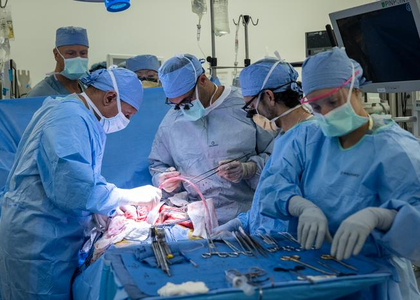US surgeons perform world’s first in-human bladder transplant
By IANS | Updated: May 18, 2025 18:47 IST2025-05-18T18:40:45+5:302025-05-18T18:47:54+5:30
New York, May 18 A team of US surgeons has performed the world’s first in-human bladder transplant, it ...

US surgeons perform world’s first in-human bladder transplant
New York, May 18 A team of US surgeons has performed the world’s first in-human bladder transplant, it was announced on Sunday.
Surgeons from Keck Medicine of University of Southern California and University of California Los Angeles Health completed the surgery at Ronald Reagan UCLA Medical Center, in a joint effort by Inderbir Gill, founding executive director of USC Urology, and Nima Nassiri, MD, urologic transplant surgeon and director of the UCLA Vascularized Composite Bladder Allograft Transplant Program.
“This surgery is a historic moment in medicine and stands to impact how we manage carefully selected patients with highly symptomatic ‘terminal’ bladders that are no longer functioning,” said Gill.
“Transplantation is a lifesaving and life-enhancing treatment option for many conditions affecting major organs, and now the bladder can be added to the list,” he added.
The patient had been dialysis-dependent for seven years. He lost the majority of his bladder during surgery to resect cancer over five years ago, leaving the remainder of his bladder too small and compromised to function appropriately. Both of his kidneys were subsequently removed due to renal cancer.
“This first attempt at bladder transplantation has been over four years in the making,” Nassiri said. “For the appropriately selected patient, it is exciting to be able to offer a new potential option.”
Nassiri and Gill worked together for several years at the Keck School to develop the new surgical technique, design a clinical trial and secure the necessary regulatory approvals.
To address these deficits, Gill and Nassiri performed a combined kidney and bladder transplant, allowing the patient to immediately stop dialysis and produce urine for the first time in seven years. First the kidney, then the bladder, were transplanted. The new kidney was then connected to the new bladder. The entire procedure took approximately eight hours.
“The kidney immediately made a large volume of urine, and the patient’s kidney function improved immediately,” Nassiri added. “There was no need for any dialysis after surgery, and the urine drained properly into the new bladder.”
“Despite the complexity of the case, everything went according to plan and the surgery was successful,” said Gill. “The patient is doing well, and we are satisfied with his clinical progress to date.”
Disclaimer: This post has been auto-published from an agency feed without any modifications to the text and has not been reviewed by an editor
Open in app